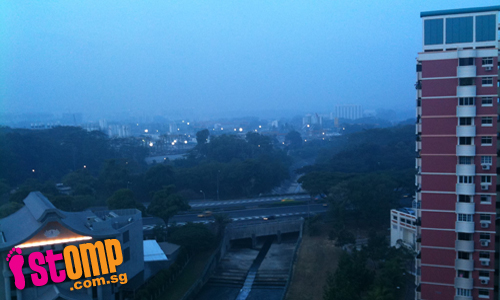
STOMPer eastsider woke up to find the CBD skyline, which was normally visible from his balcony, obscured by the haze. There was also a distinct burning smell.
With less than normal rainfall, more hot days will be coming our way this March. This is a result of the El Nino weather effect, caused by interaction between the Pacific Ocean and the atmosphere.
In the STOMPer's iPhone contribution:
"I woke up this morning and smelled a burning smell in the air reminiscent of the haze.
"Looking out of my balcony, I saw the landscape enveloped in haze.
"The CBD skyline should normally be visible in the distance in this photo."
Related posts: Bush fire rages at Expo area (19th February 2010)
Related articles: Sorry kid, it's going to stay hot and dry for a while (2nd March 2010) (Mirror)
Last month the driest Feb in 140 years (1st March 2010) (Mirror)
February 2010 is driest month for Singapore since records began in 1869 (2010) (Mirror)
Driest February ever recorded to date in Singapore (25th February 2010) (Mirror)
February's a dry, hot season in Singapore (19th February 2010) (Mirror)
Smoke in the air due to bush fires (18th February 2010) (Mirror)
71 bush fires in two weeks (18th February 2010) (Mirror)
Indeed, it was especially hazy in Pasir Ris this morning. I guess the eastern side of Singapore, which is naturally somewhat drier and receives less rainfall than other parts of the island, is more prone to bush fires, given this current dry spell.
The latest 24-hour Pollution Standards Index (PSI) update, which was released only at 4 pm earlier on, shows a PSI of 36 for eastern Singapore. Although it indicates that the air quality is still considered Good, it is still quite a large jump from the previous day's readings, which gave a PSI of 21.
One potential problem I have with the way the PSI is being updated is that it covers a span of 24 hours. However, this might conceal large rises and falls in the PSI within that 24-hour range. For example, if a bush fire started, but was then eventually put out after a short while, the PSI reading might have crossed over into the Moderate range, except that this rise was cancelled out by the low PSI over the rest of the 24 hours. Would 3-hour updates or even hourly updates be preferable?
An example can be seen from this morning, where it was much hazier than usual in Pasir Ris. Yet despite the noticeable decline in air quality, the PSI (which had been obsolete by more than 12 hours) indicated that the air quality was supposed to be Good. For people with potential health problems, knowing the PSI at that point in time can help spare them from a lot of discomfort.
I just hope that they won't be burning any rainforests in Malaysia and Indonesia during these few months. That would only make things even worse.